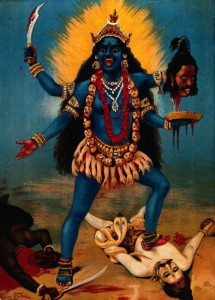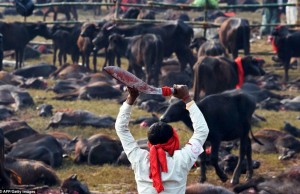In many respects, Hinduism is one of the friendliest religions toward animals. The principle of “ahimsa,” or harmlessness, has been a central Hindu virtue for thousands of years, and many schools of Hinduism encourage or require a vegetarian diet from their followers. Despite this, the worship of goddesses in Hinduism is sometimes closely associated with bloody animal sacrifices, such as the Gadhimai festival in Nepal held every four years.* This goes against the overarching spirit of the religion, and stems partly from a misunderstanding of Hindu theology, in which goddesses represent Shakti, the divine feminine principle.

Kali, a violent manifestation of Shakti (image from
Wikipedia)
As the active force which moves the universe, Shakti is often associated specifically with violent, destructive force, and so some practitioners believe that by indulging in violence and destruction themselves they are worshiping Shakti. This ignores the fact that Hindu spiritual practice is not about blind indulgence, but harnessing and disciplining one’s nature to achieve a higher state of consciousness.
The proper use of violent force, and the dangers of giving it free reign, are both portrayed in the origin story of Kali, one of the most popular goddesses (and sadly, most often sacrificed to). She is said to have come to Earth in order to defeat a plague of demons, but because every drop of blood shed would invariably birth another demon, Kali was forced to drink it in order to prevail. However, she herself then became drunk on the blood, and went on a wild rampage which itself threatened to destroy all life on Earth, necessitating the self-sacrifice of her husband Shiva to quell her bloodlust and bring her to her senses again.

Butcher and buffalo at the Gadhimai festival in Nepal (Image courtesy
oriana.italy)
The moral message is clear: even if violence is occasionally necessary against extreme evil, we must always avoid indulging in bloodlust, or else we risk becoming as wicked as the enemy we would seek to defeat. Yet many self-identified Hindus have overlooked or ignored this lesson, and by needlessly slaughtering hundreds of thousands of innocent animals as a form of “worship,” participants in Gadhimai and other sacrifices more closely resemble demons than the goddesses who combat them.
*As of the publication date, the temple in charge of Gadhimai has declared that the next festival, in 2019, will not involve animal sacrifice.
(Featured image: Hindu saint Caitanya preaching to the animals, who dance with joy in his presence – courtesy Krishna Path)





